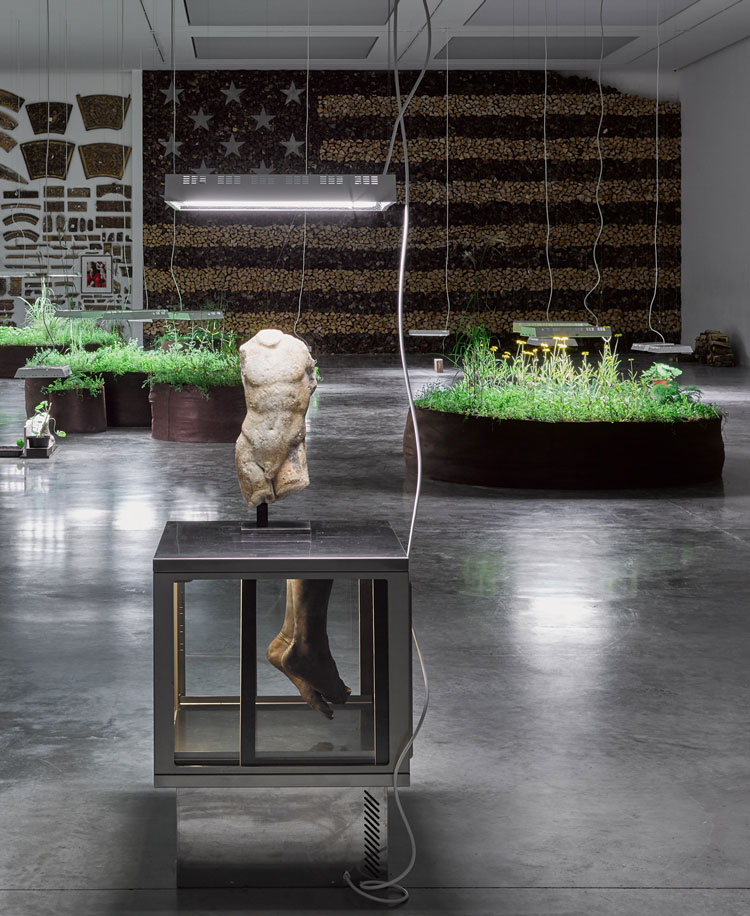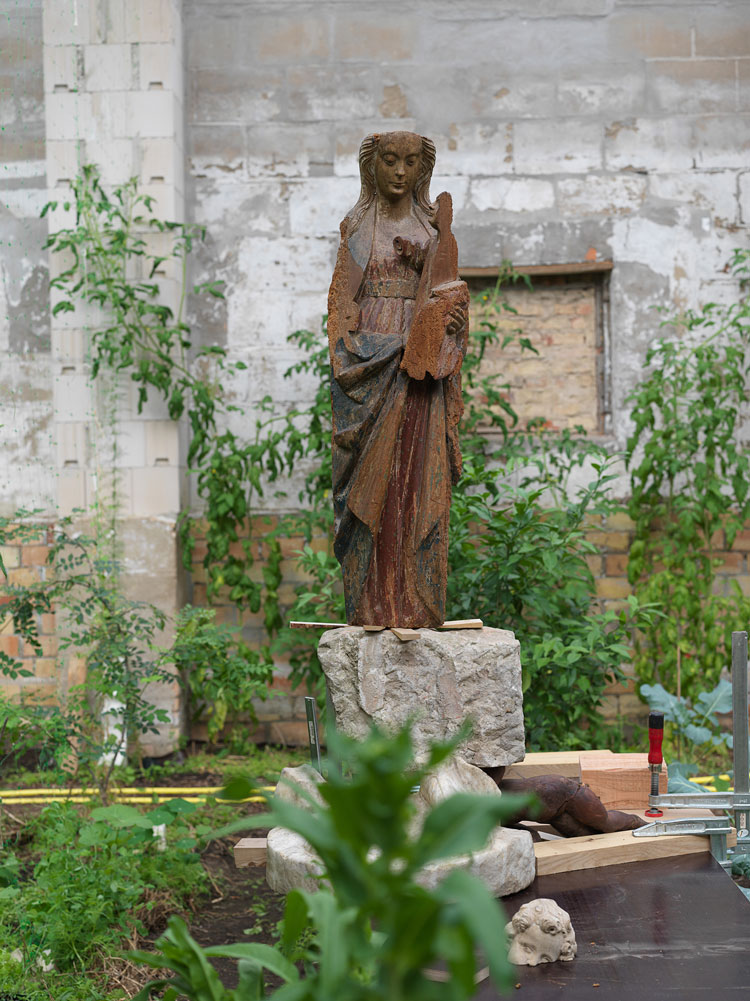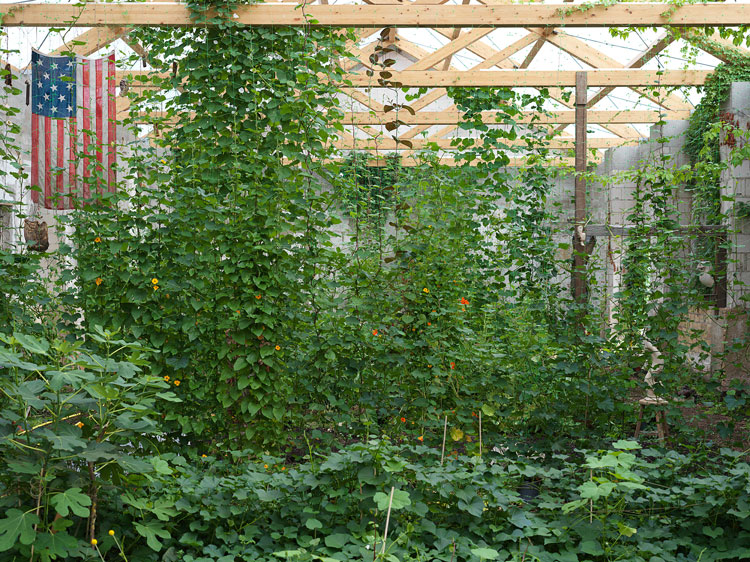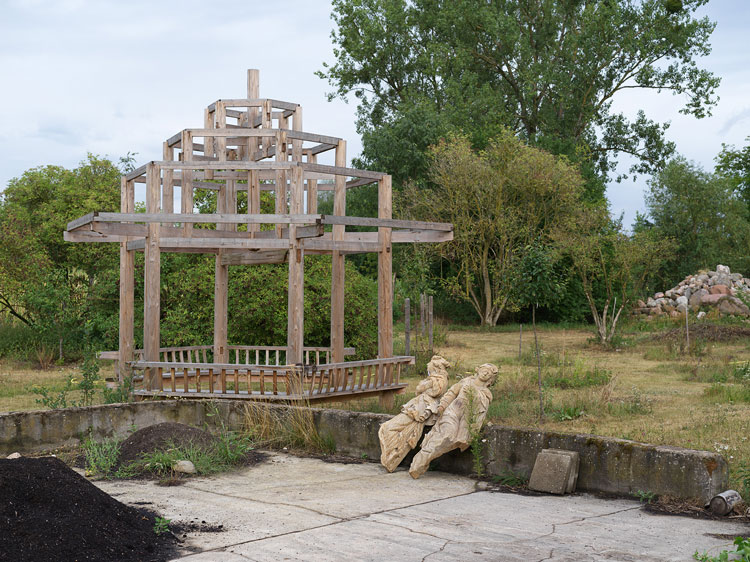

White Cube Bermondsey, London
11 September – 2 November 2020
by BETH WILLIAMSON
This exhibition of new work by Danh Vo (b1975, Vietnam) is a haven of pastoral calm in the midst of Bermondsey, in south-east London, but it is a haven with a twist, a rough underbelly that, at times, brings disquiet and disrupts an otherwise tranquil space. So what is going on here?
The background for Vo’s exhibition, we are told, is the rise and fall of empires. It is titled Chicxulub after the Mexican town that gave its name, in turn, to the gigantic crater from a comet or asteroid that killed the majority of the Earth’s plant and animal life around 66m years ago. The significant historical events that Vo lists begin in May 330BC, with Alexander the Great’s march on Persepolis, the capital of the Achaemenid Empire, which he burns to the ground. A string of events follows and ends in August 1945 with the US dropping atomic bombs on the cities of Hiroshima and Nagasaki. These kinds of catastrophic events act as a backdrop for an exhibition that feels particularly pertinent as we live through another sort of catastrophe, the presence of Covid-19.
[image13]
Across all the galleries at White Cube Bermondsey, Vo displays work developed at Güldenhof, his farm in east Germany where he brought together a number of themes that have interested him for the last 10 years. The seemingly disparate themes include the seduction and violence of Catholicism, the similarities between the dissemination of Christianity and the contemporary movement of international brands in the marketplace, and the interconnected nature of life across the globe. It is visually and materially eclectic, but when we think of Vo’s thematic approach, there is continuity there if we look for it.
[image2]
In the outside courtyard of the gallery, the work Dong Pavilion (2018), made of cedarwood, doesn’t give much away about what we might find inside. The interior corridor, too, contains a small number of works that only hint at what is to come, so I want to jump straight to the main gallery spaces.
[image3]
The 9 x 9 x 9 gallery space contains just three works installed together: two written pieces by the artist’s father, Phung Vo, and a 16th-century bronze Christ and a tree. The writing by Phung Vo, entitled 2.2.1861, is a transcription, requested by Danh Vo and made in 2009, of the last letter of the French Catholic missionary Théophane Vénard to his father before he was decapitated in Vo’s native Vietnam in 1861. This brings together Vénard’s tragic end, Christ and the apple tree, symbolic of Eve’s fall in the Garden of Eden. Alongside this is the Vo family’s own tragedy, first banished to the island of Phú Quốc following the rise of communism and the fall of Saigon in 1975, then fleeing South Vietnam on a homemade boat and being rescued at sea by a Danish freighter in 1979. It is an apt beginning to an exhibition whose elements are simultaneously comforting and disturbing.
[image7]
The North Gallery is sparsely populated with a number of small installations. Fragments of Christian sculpture are combined with global brand packaging – a wooden crate that once held Beefeater dry gin and a wooden box that contained Carnation milk – while part of a wooden Roman sarcophagus and a marble panther leg, also Roman, occupy other spaces in the gallery. Accompanying these curious installations, a number of functioning woodburning stoves sit in the gallery, each with a neat pile of fresh logs ready for use. What caught my attention was the considerable network of piping connecting the stove flues to the outside world. Across the ceiling and the outside wall, flues from each stove joined up, eventually sending wood smoke into the air outside. This network of flues is a necessary practicality, but also suggests the interconnectedness of the world.
[image5]
The South Gallery is Vo’s triumph in this exhibition. Entering through a stained-glass doorway, from about 1900, we encounter so many incongruent ideas, images and materials. In the dimly lit gallery space, with no natural light, large circular enclosures full of soil and seasonal plants each have dedicated grow lamps to enable them to flourish. There is gallery seating, from which we can survey the planting as if in a garden. Around the space, we also see fragments of sculpture of different periods – Roman, Greco-Roman, 19th century and 17th century – and more of the global brand packaging we have encountered elsewhere in the gallery. There are putti fragments, torsos and broken feet intermingled with nasturtiums, a symbol of victory in conquest, taking us back to Vo’s thinking on empires, but also a symbol of creativity and so a sign of growth and hope, perhaps. Where we enter this gallery space, the wall is covered on one side with fragments of sculpture from the Christian tradition. That tradition aims to bring hope and salvation, but these sculptural remnants are broken and incomplete. On the other half of the wall, a US flag more than five metres tall and 10 metres wide has been constructed from weathered wood logs with 13 steel stars. A few logs are missing from the top righthand corner of the flag installation. The missing logs are the first to be used to fuel the wood-burning stoves throughout the exhibition spaces. By the end of the exhibition run, the flag installation will be considerably diminished, but it will have fuelled the stoves and brought warmth to gallery visitors. The exhibition itself will close on the eve of the US election.
[image10]
This is an impeccably timed exhibition. It reminds us of our catastrophic past, our difficult present and our fragile future. It reminds us, too, of our interconnectedness, of how one event can impact another, for good or ill. We might say it is nostalgic to look backwards with a kind of pastoral longing for creation and growth, but that nostalgia is tempered by a reminder of our brokenness, our failings. Equally, it might be overly optimistic to think we can find new ways of being and growing in the world, but if we do not have optimism, what do we have? I left the exhibition feeling that I had experienced a brief respite from my own current difficulties, small as they are, and a renewed optimism that I could tackle them afresh. If a visit to an exhibition can lend us just a little bit of hope in present times then it is surely worth visiting.
.jpg)
.jpg)
.jpg)
.jpg)
.jpg)
.jpg)
.jpg)
.jpg)
.jpg)



